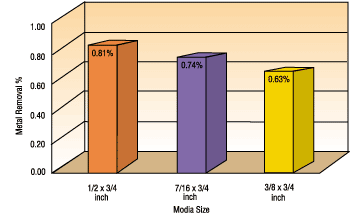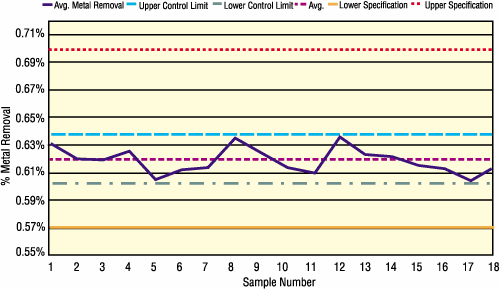Understanding Your Mass-Finishing Process
Do you have control over your mass-finishing processes so that your parts are finished the same way every time...perfectly?
#basics
Customer demands for faster delivery, improved quality and cost reduction have made mass finishing a focal point for improvement in many finishing shops. However, even with significant investments in automation, material handling systems and faster, more aggressive equipment, many companies continue to experience inconsistent and unreliable parts processing.
To eliminate these problems from mass-finishing operations, companies must understand their process capability and maintain process control. Working with a supplier that can provide specific data and help the company implement these simple, yet effective measures can often make the difference.
Featured Content
What is Process Capability?
Process capability is the measured, built-in reproducibility of the product turned out by the process. Such a determination is made using statistical data, not wishful thinking. Statistically determined limits can only then be compared to specification limits to decide if a process can consistently produce acceptable product.
Whether it is an existing, improved or newly developed finishing process, the most important thing is that you know and understand it. Few companies know the percent metal removal or the Ra averages necessary to produce consistently acceptable parts. All mass-finishing processes can be documented to show an upper and lower control limit for any given parameter (Fig. 1). Ideally, upper and lower control limits should be based upon the most critical measurement of your part (percent metal removal, Ra average, radius, etc.). In many cases, it may be necessary to incorporate control limits for several measurements in order to completely define the process capability and obtain consistently acceptable parts.
The process will produce parts within these limits if the essential process variables are held constant. If these limits are inside the part specifications, then acceptable parts will be produced. If the control limits are outside the specifications limits, the process will produce rejects.
Process capability is best established through closely monitored testing and recording of data over a set period of actual production. If this is not possible, it can be closely approximated in a properly equipped process lab. Your supplier should be able to help determine what limits to establish and how to record and document the results.
Once these parameters are in place, they will not only improve the process consistency, but they can be used as quality guidelines for both your parts and finishing materials. Properly documented process capability parameters can quickly alert you to either internal or external changes that can drastically affect reject rates and rework numbers (dulling cutters, glazed media, metal hardness fluctuations, Ra increases, etc.).
Another asset your supplier should provide in regard to processing is process improvement data. Many existing processes can be significantly improved with a small amount of testing and data collection. Changes based on this data can be as simple as a media diameter size (Fig. 2), to the purchasing of new equipment (Fig. 3). Charting data such as this can help you decide which equipment using which media would work best for your finishing needs. The old response of “we have always run them this way” is no longer valid. Any process improvement not made by a company will most likely be made by its competitor. Once your process capability has been charted and fully understood, the next step is to incorporate process control.
What is Process Control?
Process control is the maintenance of predetermined and approved process settings for both equipment and product (media, compound, media-to-part ratio, etc.) in order to maintain process capability.
| TABLE I—Sample Of Process Control Sheet | |
| Process Control Sheet Part No. 4322 |
|
| Machine settings Media type Time cycle Water settings Compound type Compoiund settings Media level Media to parts ratio Drains |
Amplitude 3/16 inch, 1200 rpm Ceramic media 45 min 12 gph VF-77T liquid 1.5 oz/gal Maintain 75% 3:1 Fully open |
If multiple processes are used in a facility, each separate process should be documented and posted for all operators to reference (Table I). Fluctuations in process control can affect the quality of the finished parts as drastically as the variables discussed earlier. A suggested guideline would be to have the process control checked daily or at shift changes. The importance of process control is to maintain your process capability. The most efficient and productive process can easily slip out of control if not closely monitored and maintained.
Considering the time, money and personnel efforts that companies put forth in their manufacturing process, it only makes sense to incorporate comparable efforts in their finishing process.
Understanding process capability and control will reduce reject rates and rework and provide further process improvement methods. True improvement of a process comes from balancing repeatability and consistency with the capability of meeting your customer's requirements. The key to meeting your customer's requirement is initially meeting your own.
RELATED CONTENT
-
Touch-up Options for Powder Coated Parts
Is it true that powder coating cannot be touched up? Powder coating expert Rodger Talbert offers options for powder coating touch-ups.
-
Alkaline Cleaning Guide
Gregg Sanko, Senior Chemist, Oakite Products, Inc. provides an overview of the alkaline cleaning process.
-
Fixing Corrosion Between Anodized Aluminum and Steel
Anne Deacon Juhl, Ph.D., with AluConsult, says Galvanic corrosion is due to an electrical contact with a more noble metal or a nonmetallic conductor in a conductive environment.





















